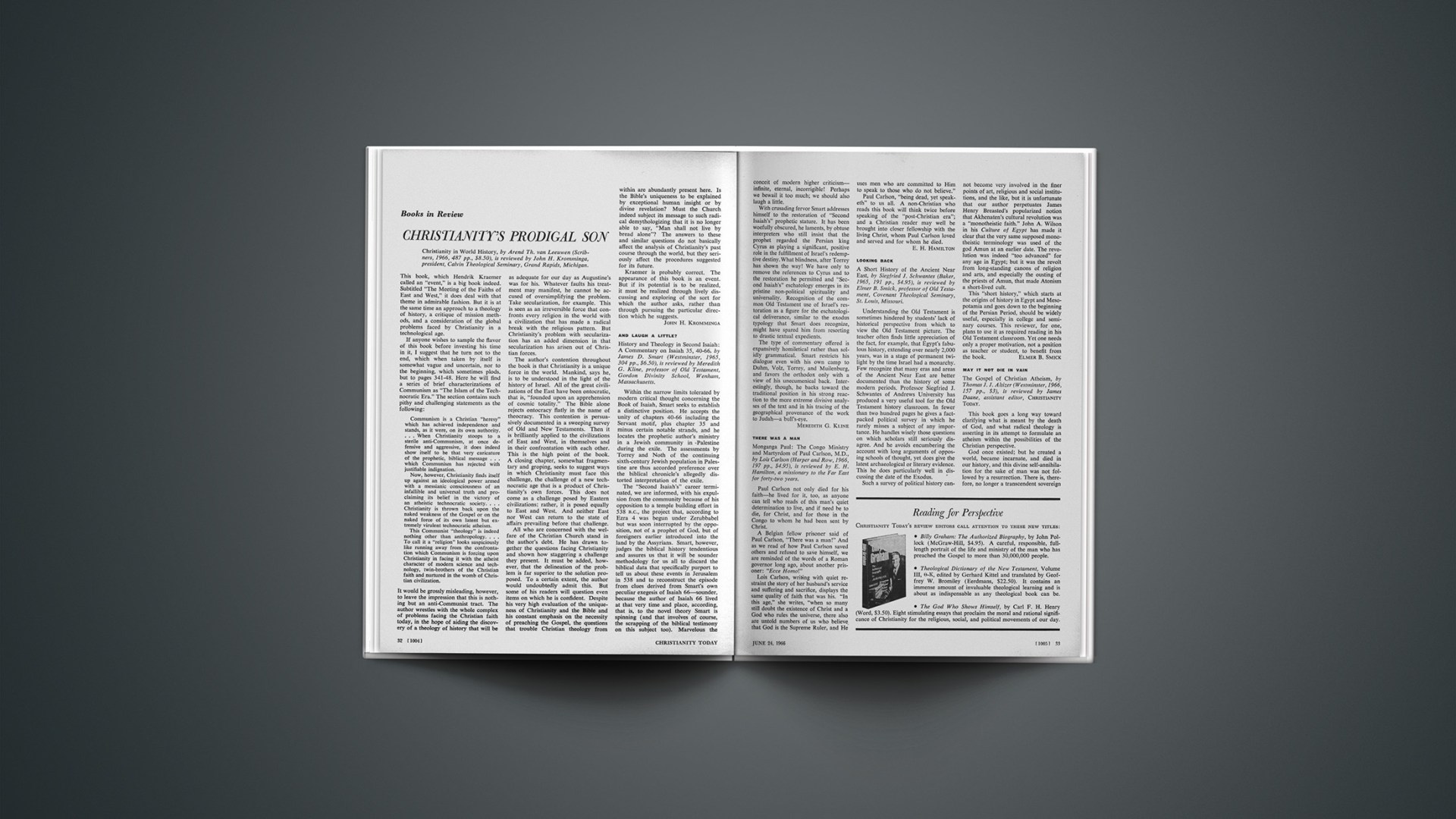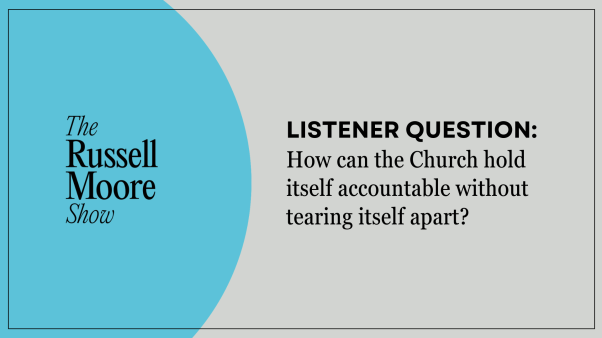Christianity’S Prodigal Son
Christianity in World History, by Arend Th. van Leeuwen (Scribners, 1966, 487 pp., $8.50), is reviewed by John H. Kromminga, president, Calvin Theological Seminary, Grand Rapids, Michigan.
This book, which Hendrik Kraemer called an “event,” is a big book indeed. Subtitled “The Meeting of the Faiths of East and West,” it does deal with that theme in admirable fashion. But it is at the same time an approach to a theology of history, a critique of mission methods, and a consideration of the global problems faced by Christianity in a technological age.
If anyone wishes to sample the flavor of this book before investing his time in it, I suggest that he turn not to the end, which when taken by itself is somewhat vague and uncertain, nor to the beginning, which sometimes plods, but to pages 34 1–48. Here he will find a series of brief characterizations of Communism as “The Islam of the Technocratic Era.” The section contains such pithy and challenging statements as the following:
Communism is a Christian “heresy” which has achieved independence and stands, as it were, on its own authority.… When Christianity stoops to a sterile anti-Communism, at once defensive and aggressive, it does indeed show itself to be that very caricature of the prophetic, biblical message … which Communism has rejected with justifiable indignation.
Now, however, Christianity finds itself up against an ideological power armed with a messianic consciousness of an infallible and universal truth and proclaiming its belief in the victory of an atheistic technocratic society.… Christianity is thrown back upon the naked weakness of the Gospel or on the naked force of its own latent but extremely virulent technocratic atheism.
This Communist “theology” is indeed nothing other than anthropology.… To call it a “religion” looks suspiciously like running away from the confrontation which Communism is forcing upon Christianity in facing it with the atheist character of modern science and technology, twin-brothers of the Christian faith and nurtured in the womb of Christian civilization.
It would be grossly misleading, however, to leave the impression that this is nothing but an anti-Communist tract. The author wrestles with the whole complex of problems facing the Christian faith today, in the hope of aiding the discovery of a theology of history that will be as adequate for our day as Augustine’s was for his. Whatever faults his treatment may manifest, he cannot be accused of oversimplifying the problem. Take secularization, for example. This is seen as an irreversible force that confronts every religion in the world with a civilization that has made a radical break with the religious pattern. But Christianity’s problem with secularization has an added dimension in that secularization has arisen out of Christian forces.
The author’s contention throughout the book is that Christianity is a unique force in the world. Mankind, says he, is to be understood in the light of the history of Israel. All of the great civilizations of the East have been ontocratic, that is, “founded upon an apprehension of cosmic totality.” The Bible alone rejects ontocracy flatly in the name of theocracy. This contention is persuasively documented in a sweeping survey of Old and New Testaments. Then it is brilliantly applied to the civilizations of East and West, in themselves and in their confrontation with each other. This is the high point of the book. A closing chapter, somewhat fragmentary and groping, seeks to suggest ways in which Christianity must face this challenge, the challenge of a new technocratic age that is a product of Christianity’s own forces. This does not come as a challenge posed by Eastern civilizations; rather, it is posed equally to East and West. And neither East nor West can return to the state of affairs prevailing before that challenge.
All who are concerned with the welfare of the Christian Church stand in the author’s debt. He has drawn together the questions facing Christianity and shown how staggering a challenge they present. It must be added, however, that the delineation of the problem is far superior to the solution proposed. To a certain extent, the author would undoubtedly admit this. But some of his readers will question even items on which he is confident. Despite his very high evaluation of the uniqueness of Christianity and the Bible and his constant emphasis on the necessity of preaching the Gospel, the questions that trouble Christian theology from within are abundantly present here. Is the Bible’s uniqueness to be explained by exceptional human insight or by divine revelation? Must the Church indeed subject its message to such radical demythologizing that it is no longer able to say, “Man shall not live by bread alone”? The answers to these and similar questions do not basically affect the analysis of Christianity’s past course through the world, but they seriously affect the procedures suggested for its future.
Kraemer is probably correct. The appearance of this book is an event. But if its potential is to be realized, it must be realized through lively discussing and exploring of the sort for which the author asks, rather than through pursuing the particular direction which he suggests.
JOHN H. KROMMINGA
And Laugh A Little?
History and Theology in Second Isaiah: A Commentary on Isaiah 35, 40–66, by James D. Smart (Westminster, 1965, 304 pp., $6.50), is reviewed by Meredith G. Kline, professor of Old Testament, Gordon Divinity School, Wenham, Massachusetts.
Within the narrow limits tolerated by modern critical thought concerning the Book of Isaiah, Smart seeks to establish a distinctive position. He accepts the unity of chapters 40–66 including the Servant motif, plus chapter 35 and minus certain notable strands, and he locates the prophetic author’s ministry in a Jewish community in-Palestine during the exile. The assessments by Torrey and Noth of the continuing sixth-century Jewish population in Palestine are thus accorded preference over the biblical chronicle’s allegedly distorted interpretation of the exile.
The “Second Isaiah’s” career terminated, we are informed, with his expulsion from the community because of his opposition to a temple building effort in 538 B.C., the project that, according to Ezra 4 was begun under Zerubbabel but was soon interrupted by the opposition, not of a prophet of God, but of foreigners earlier introduced into the land by the Assyrians. Smart, however, judges the biblical history tendentious and assures us that it will be sounder methodology for us all to discard the biblical data that specifically purport to tell us about these events in Jerusalem in 538 and to reconstruct the episode from clues derived from Smart’s own peculiar exegesis of Isaiah 66—sounder, because the author of Isaiah 66 lived at that very time and place, according, that is, to the novel theory Smart is spinning (and that involves of course, the scrapping of the biblical testimony on this subject too). Marvelous the conceit of modern higher criticism—infinite, eternal, incorrigible! Perhaps we bewail it too much; we should also laugh a little.
With crusading fervor Smart addresses himself to the restoration of “Second Isaiah’s” prophetic stature. It has been woefully obscured, he laments, by obtuse interpreters who still insist that the prophet regarded the Persian king Cyrus as playing a significant, positive role in the fulfillment of Israel’s redemptive destiny. What blindness, after Torrey has shown the way! We have only to remove the references to Cyrus and to the restoration he permitted and “Second Isaiah’s” eschatology emerges in its pristine non-political spirituality and universality. Recognition of the common Old Testament use of Israel’s restoration as a figure for the eschatological deliverance, similar to the exodus typology that Smart does recognize, might have spared him from resorting to drastic textual expedients.
The type of commentary offered is expansively homiletical rather than solidly grammatical. Smart restricts his dialogue even with his own camp to Duhm, Volz, Torrey, and Muilenburg, and favors the orthodox only with a view of his unecumenical back. Interestingly, though, he backs toward the traditional position in his strong reaction to the more extreme divisive analyses of the text and in his tracing of the geographical provenance of the work to Judah—a bull’s-eye.
MEREDITH G. KLINE
There Was A Man
Monganga Paul: The Congo Ministry and Martyrdom of Paul Carlson, M.D., by Lois Carlson (Harper and Row, 1966, 197 pp., $4.95), is reviewed by E. H. Hamilton, a missionary to the Far East for forty-two years.
Paul Carlson not only died for his faith—he lived for it, too, as anyone can tell who reads of this man’s quiet determination to live, and if need be to die, for Christ, and for those in the Congo to whom he had been sent by Christ.
A Belgian fellow prisoner said of Paul Carlson, “There was a man!” And as we read of how Paul Carlson saved others and refused to save himself, we are reminded of the words of a Roman governor long ago, about another prisoner: “Ecce Homo!”
Lois Carlson, writing with quiet restraint the story of her husband’s service and suffering and sacrifice, displays the same quality of faith that was his. “In this age,” she writes, “when so many still doubt the existence of Christ and a God who rules the universe, there also are untold numbers of us who believe that God is the Supreme Ruler, and He uses men who are committed to Him to speak to those who do not believe.”
Paul Carlson, “being dead, yet speaketh” to us all. A non-Christian who reads this book will think twice before speaking of the “post-Christian era”; and a Christian reader may well be brought into closer fellowship with the living Christ, whom Paul Carlson loved and served and for whom he died.
E. H. HAMILTON
Looking Back
A Short History of the Ancient Near East, by Siegfried J. Schwantes (Baker, 1965, 191 pp., $4.95), is reviewed by Elmer B. Smick, professor of Old Testament, Covenant Theological Seminary, St. Louis, Missouri.
Understanding the Old Testament is sometimes hindered by students’ lack of historical perspective from which to view the Old Testament picture. The teacher often finds little appreciation of the fact, for example, that Egypt’s fabulous history, extending over nearly 2,000 years, was in a stage of permanent twilight by the time Israel had a monarchy. Few recognize that many eras and areas of the Ancient Near East are better documented than the history of some modern periods. Professor Siegfried J. Schwantes of Andrews University has produced a very useful tool for the Old Testament history classroom. In fewer than two hundred pages he gives a fact-packed political survey in which he rarely misses a subject of any importance. He handles wisely those questions on which scholars still seriously disagree. And he avoids encumbering the account with long arguments of opposing schools of thought, yet does give the latest archaeological or literary evidence. This he does particularly well in discussing the date of the Exodus.
Such a survey of political history cannot become very involved in the finer points of art, religious and social institutions, and the like, but it is unfortunate that our author perpetuates James Henry Breasted’s popularized notion that Akhenaten’s cultural revolution was a “monotheistic faith.” John A. Wilson in his Culture of Egypt has made it clear that the very same supposed monotheistic terminology was used of the god Amun at an earlier date. The revolution was indeed “too advanced” for any age in Egypt; but it was the revolt from long-standing canons of religion and arts, and especially the ousting of the priests of Amun, that made Atonism a short-lived cult.
This “short history,” which starts at the origins of history in Egypt and Mesopotamia and goes down to the beginning of the Persian Period, should be widely useful, especially in college and seminary courses. This reviewer, for one, plans to use it as required reading in his Old Testament classroom. Yet one needs only a proper motivation, not a position as teacher or student, to benefit from the book.
ELMER B. SMICK
May It Not Die In Vain
The Gospel of Christian Atheism, by Thomas J. J. Altizer (Westminster, 1966, 157 pp., $3), is reviewed by James Daane, assistant editor,CHRISTIANITY TODAY.
This book goes a long way toward clarifying what is meant by the death of God, and what radical theology is asserting in its attempt to formulate an atheism within the possibilities of the Christian perspective.
God once existed; but he created a world, became incarnate, and died in our history, and this divine self-annihilation for the sake of man was not followed by a resurrection. There is, therefore, no longer a transcendent sovereign Lord above and beyond the movements of life and history, no God to whom we can return, no Eternal who is our eternal dwelling place. He once was, but he actually died and is no more. This is the meaning of the name of Jesus, which the radical theologians want to retain. The traditional idea of a Christ who is God, who rose again from the dead, and who by granting forgiveness of sin and guilt returns us to God and to the primordial state of innocence, carries with it a No-saying to the movements and vitalities of life and history. This Christ must therefore be surrendered. But the name of Jesus, which bespeaks an incarnation, an authentic kenosis, and the death of God, releases us from that repressive sense of a fall from an initial state of innocence and opens up the possibility of a Yes-saying both to the self and to the vitalities and movements of the history and world in which we live.
Altizer, of course, has no true knowledge or hearty confidence that God has actually died, and he admits it. One must assume the risk of life, he says, and take a chance either on the classical Son of God, the Christ of the historical Church, or on the Jesus who bespeaks the actual death of God. Altizer takes his chance on this Jesus. Why? Does his sense of guilt, of damnation and hell become more bearable if the final Judge is dead? This is not a facetious question, for Altizer is no smiling liberal who sees no evidence of hell and damnation. He recognizes that artists and poets today speak more about damnation and hell than do most men of the pulpit—a fact he bitingly adduces to show that even the Church does not take seriously the old view of God and the world. Altizer, however, wagers on the Jesus-of-the-death-of-God as the more likely winner, since the Church’s image of the traditional Christ returns man to an antecedent living God and to a primordial state of innocence, thereby demanding a negation of life and of the forward movements of history.
Altizer urges that mankind’s historical consciousness is only two hundred years old and that the awareness of what this consciousness means has progressed from Blake, Nietzsche, and Hegel to the point where today men are beginning to see that God is truly dead and that traditional Christianity is utterly meaningless to the modern man. “Ours,” he says, “is the first form of consciousness and experience that has evolved after the full historical realization of the death of God.” The Christian who today “chooses the orthodox image of Christ is making a wager in which he stands to forfeit all the life and energy of a world that is totally alien to the Church’s Christ.”
Needless to say, the Christian atheism of the radical theologians does not emerge in continuity with the Christianity of the past. Altizer’s radical theology is as new as the affirmation within Christianity that God is dead. It is essentially anti-Christ, a quite new, free-wheeling, and impulsive syncretion of psychology, oriental mysticism, and an inverted definition of Christianity’s kenotic incarnation. Altizer’s point of departure is not revelation but wager, a wager dictated by the current common error of allowing human existence to formulate the questions to which revelation must perforce give the fitting answer. Evangelicals should realize much more than they do that this method, made impressive by Paul Tillich, is followed not only by today’s radical theologians but also by those confessed Christians of the pulpit who reduce Christianity to nothing more than a remedy for human need.
In classical Christianity, God came in the form of a servant to serve human need but in becoming a servant remained God. In radical theology, God serves man and in so doing dies and ceases to be. In some liberal versions, Christianity is merely something that meets all human needs and solves all human problems. Some more “orthodox” versions say that man must first learn to know that he is a sinner before Christianity’s Saviour has relevance. In both kinds—as in the radical theology of Altizer—God is meaningful only within a life-situation and must therefore be reduced to the terms of the situation’s demands and needs. In Altizer, and in these liberal and conservative views, God must serve man, even if he must die to do so.
Robert McAfee Brown says that The Gospel of Christian Atheism is neither gospel, nor Christian, nor atheism, and that its attempt to celebrate the death of God only demonstrates the “death of the ‘death-of-God theology.’ ” But before it dies one could wish that liberal and conservative ministers and theologians who have unwittingly succumbed to its method would see the reflection of this method within their own theologies. Its balder expression in Altizer could serve to enlighten both. If it does, the death-of-God theology will not have lived in vain. For all who reduce the truth of God in Christ to a mere remedy for human need are unwittingly committed to a theological method that leads to the death of God. For the God who is no more than a servant of human need is not God.
JAMES DAANE
Publication Justified
The Quest Through the Centuries, by Harvey K. McArthur (Fortress, 1966, 173 pp., $3.75), is reviewed by Everett F. Harrison, professor of New Testament, Fuller Theological Seminary, Pasadena, California.
Another volume takes its place on the library shelves alongside the many others on the historical Jesus. The problem is essentially twofold: how to know Jesus as he really was, and how to resolve the tension between the historical Jesus and the Christ of faith. The author defines the Jesus of history to be “Jesus as he would have been described by a secular historian had such a person been present in first-century Palestine.” The Christ of faith is “that same historical figure as described or defined by the professional or popular theology of the church.”
Since so much has been written in our day on this subject, the prospective reader may well ask what there is about this book that justifies its publication. Two things may be said here. It is valuable for its clear and condensed presentation of the modern debate and will be a useful handbook for those who want to grasp the essentials without having to make their way through a mass of detail. This feature alone would warrant its publication. The other aspect is the perspective given the reader for assessing the quest. Instead of starting with modern times and the growth of the critical spirit, the author covers the whole subject from the days of the early Church to our own time, as the title of the book suggests.
He begins by distinguishing history, kerygma, and record. To the first belongs the Christ-event, to the second the proclamation of the Church’s convictions about Christ, and to the third the report of the Church concerning Jesus’ life and ministry, whether in the form of oral tradition or of documents. It is difficult to establish the facts of the history because of variability in the records; even if a neutral observer had been on hand to tabulate everything that happened, he would not have been able to arrive at the kerygma. In the records we possess (the Gospels), no sharp line is drawn between the history and the kerygma. The two are woven together.
The early Church narrowed the quest by its acceptance of the Four Gospels. Modern research affirms the wisdom of this limitation, as little has been gained by a study of other sources. Attempts to resolve difficulties in the Gospels by leaders of the ancient Church, including Augustine, were handicapped by the notion that the Evangelists were independent witnesses to what they record. Views of literary dependence had not yet been worked out. But at least the early Church made a start by working at the problem of gospel harmony.
It is in chapters three and four that the author makes his most unusual contribution, for here he describes three Lives of Christ dating from the fourteenth century that proved influential, and then discusses the rash of gospel harmonies that appeared in the sixteenth century. Some of these were integrated, resembling in this respect the second-century Diatessaron of Tatian; others were parallel harmonies that were especially useful for those interested in the problems presented by parallel accounts.
Chapter five is devoted to a review of the modern quest from Reimarus onward; the author traces the stages whereby the search became concentrated on the Four Gospels, then on the Synoptics, then on the two-source theory of the origin of the Synoptics, and at length on the period of oral tradition in terms of the molding influence of the Christian community as seen through the eyes of the form critics. Of these latter figures, Bultmann has special significance because of his tendency to make the Gospels sources for the understanding of the Church and only slightly for the understanding of Jesus. Though Bultmann is much more radical than Kähler, he has this in common with him, that the point of main interest is in the Christ of the kerygma rather than in the historical Jesus.
A brief review of the New Quest is undertaken, with special reference to the work of James M. Robinson, together with the reaction of British scholarship to the Bultmannian and post-Bultmannian developments, and the reaction of certain Scandinavian and German scholars who are much more optimistic about the gospel records as sources of reliable information about Jesus than the post-Bultmannians.
Not content with a historical review, the author concludes with a statement of options, choosing for himself the position that “what is necessary is confidence in an essential continuity and commensurability between the Gospel portrait and the Jesus of history.” This is a sound and positive note, but it would be more so if it were supported by inclusion of the witness of the Spirit, by which that essential portrait is impressed on the continuing Church from age to age.
EVERETT F. HARRISON
Not Like A Bomb
The Morning Star: Wycliffe and the Dawn of the Reformation, by G.H. W. Parker (Eerdmans, 1965, 248 pp., $3.75), is reviewed by W. Stanford Reid, chairman, Department of History, University of Guelph, Guelph, Ontario.
This volume is the third (but the fifth to appear) in the series “The Advance of Christianity Through the Centuries,” edited by Professor F. F. Bruce. In it Professor G. H. W. Parker of Canterbury University, New Zealand, deals with the century and a half of European church history prior to the appearance of Luther, in an effort to explain the origins of the Reformation.
Although the period with which Professor Parker deals is very interesting because it is very like our own day, it is extremely difficult to analyze and to reduce to manageable size, since many different trends and movements appeared within it. The strands of the tapestry become so intricately intertwined that one almost despairs of understanding the pattern. The author begins with John Wycliffe in England and, after three chapters on him and his followers, goes on to explain what was happening in the rest of Europe and even outside Europe. Generally speaking, he gives a comprehensible account of events down to the time of the rise of the Erasmian program for reform in the sixteenth century.
The main subject of the book is really ecclesiastical reform, a theme upon which, as Professor Parker shows, many men played somewhat different variations. While he deals at considerable length with Wycliffe and Hus, the two best-known reformers of the period, he also takes up some of those less well known, such as Standonck of Paris and Zerbolt of Zutphen. He shows quite clearly that the Protestant Reformation did not burst like a bomb upon an unprepared world but had strong links with the reform movements of the Middle Ages. Medieval evangelicals had for a long time been crying out for radical changes in a church that was becoming increasingly corrupt. If Christianity was to survive, the Reformation was inevitable. The author does well to stress this.
One of the book’s particularly good points is its expositions of the views of the various intellectual leaders from Wycliffe to Erasmus. These are clear, concise, and readily understandable even by those with little theological training.
Yet the book is somewhat disappointing. For one thing, the author gives what seems to be disproportionate space to the Church in England: four of fifteen chapters. The ecclesiastical situation in fifteenth-century England hardly seems to have warranted that concentration. One of these chapters might well have been given to the important economic and social developments taking place in Europe at the time, which undoubtedly had a profound influence upon the Reformation in the sixteenth century. Unfortunately, Professor Parker paid little attention to this aspect of the story. And one might also complain that at times the writing becomes somewhat pedestrian in the presentation of a plethora of facts.
Nevertheless, the author has used the results of modern scholarship to good effect, and his work will be very useful to those who seek to understand the background of the Reformation.
W. STANFORD REID
Paul And Myth
The Eschatology of Paul in the Light of Modern Scholarship, by Henry M. Shires (Westminster, 1966, 288 pp., $6.95), is reviewed by William W. Buehler, professor of New Testament, Barrington College, Barrington, Rhode Island.
Contemporary biblical studies often manifest an antipathy to the idea that the first task is to understand what Scripture itself is saying rather than to impose one’s own presuppositions upon it. In such a context, a book like this is refreshing. The professor of New Testament at the Episcopal Theological School, Cambridge, Massachusetts, has set before himself the task of formulating a “faithfully Biblical eschatology” in order to rediscover for the Church “a forgotten or misunderstood dimension of the Gospel.” In studying the major categories of Paul’s thought—the Parousia, resurrection, judgment, life to come, spiritual body, and sacraments—Shires makes every effort to do justice to Paul by dealing forthrightly with the Scriptures.
In such an endeavor, the problem of the language used and of the relation of the text to history stands in the foreground. While some Christians are satisfied with an uncritical literal approach to the Bible’s eschatological teaching, many are looking elsewhere for clarification. What do these symbols mean? What is Paul saying to us today? Is demythologizing the answer?
Shires responds with an emphatic “No.” What he proposes is a remythologizing, i.e., an “attempt to understand the background of … [Paul’s] symbolism so that by it his meaning … is clarified.” Paul may use mythological language, but this does not mean that his beliefs belong only to an earlier age and have no abiding truth or relevance for us today. Bultmann’s reinterpretation of eschatological statements in terms of religious experience is rejected on two counts. First, his approach does not do justice to “the time-category in which we are saved,” and secondly, he is too arbitrary in his altering of and subtracting from the text. Shires rightly argues that “the relationship between revelation and its medium is so close that neither can stand without the other.”
According to Shires, myth is a legitimate means of describing religious objects. Its purpose is to “present that which lies beyond the descriptive power of words.” This transcendental imagery does not, however, disallow the reality of the historical process. Bultmann is wrong when, standing in the Hellenistic tradition, he says that “history is swallowed up by eschatology.” Shires insists that early Christian eschatology is firmly anchored in the facts of history.
Many conservatives will not wholly agree with the author’s understanding of what is literal and what is symbolic in Paul’s eschatological language. For instance, he rejects J. A. T. Robinson’s notion that Paul was mistaken in expecting Christ’s imminent return but agrees with R. Niebuhr that “the symbol of the second coming of Christ can neither be taken literally nor dismissed as unimportant.”
The reader will quickly note that Shires’s basic orientation is that of Oscar Cullmann. God’s redemptive processes have taken place in time, and in the Bible there is no antithesis between time and eternity. For Paul all history is chronological progression, and his eschatology has the same tension between present and future as does that of Jesus. In this age the Messianic Kingdom of Christ is already present, and many of the blessings of “the age to come” are available for the believer now.
This is a worthwhile book. Whether or not one agrees with all of the author’s conclusions, he can only benefit by entering into the dialogue. Interpretations are buttressed with Scripture, footnotes are copious, Bible passages fully indexed. The extent to which modern scholarship was consulted is indicated by a bibliography of 149 entries. Well over half of these scholars are dealt with in some degree in the text. This necessitates, of course, treatment that is often frustratingly brief. Rather than being an in-depth study of key men or schools of thought, Shires’s book is a survey of many viewpoints. But this approach does have its place. For the person who wants a solid exercise in biblical theology as well as an introduction to the current discussion of Paul’s eschatology, this book is recommended.
WILLIAM W. BUEHLER
Retrial For John Hus
John Hus at the Council of Constance, translated from the Latin and the Czech with notes and introduction by Matthew Spinka (Columbia University, 1965, 327 pp., $8.75), is reviewed by Jerome Ficek, associate professor of church history, Trinity Evangelical Divinity School, Deerfield, Illinois.
It is unfortunate that the name of Peter of Mladoňivice, a translation of whose Account of the Trial and Condemnation of Master John Hus in Constance makes up the bulk of this volume, does not appear in its title. This translation is the only complete one in English of the Latin account by this contemporary admirer of Hus. It is supplied with copious explanatory notes by Dr. Spinka, emeritus professor of church history of the Hartford Theological Seminary, who is the outstanding American authority on Hus and Hussitica. Besides the translations of relevant documents, including thirty-five letters of which the majority were written by Hus himself, Spinka has supplied a long introduction in which he shows how Hus rose to leadership of the Czech reformist party and became the popular preacher of the Bethlehem Chapel in Prague. Much of what Spinka says in this introduction he said in his 1941 study, John Hus and Czech Reform (University of Chicago Press); namely, that Hus was not completely dependent on the English reformer Wycliffe, that the accusations made against him were based upon distortions of his position, and that he was an “orthodox” Catholic holding a realist position on philosophy, transubstantiation, purgatory, penace, and the veneration of Mary.
This volume was published in commemoration of the 550th anniversary of the martyrdom of Hus as part of the Columbia series “Records of Civilization: Sources and Studies,” and it supplies important source material for the current discussion centering on Hus. Recently Otto Feger, Catholic archivist for the city of Constance, circulated a petition for a retrial on grounds that while the Czech reformer priest did profess some heretical ideas, his conviction was based upon accusations of heresies that he did not actually hold. Feger’s proposal, signed by many Catholics, requests that Hus be exonerated “so that his strict moral life and his sacrificial death would be to all Christians, even Catholics, an example.”
During the debate on religious liberty at the fourth session of the Second Vatican Council, Josef Cardinal Beran of Prague, recently released after sixteen years of Communist confinement, said: “In my country the Catholic Church at this time seems to be suffering expiation for sins committed in times gone by.” He made specific reference to the burning of Hus and to “the forced reconversion of a great part of the Czech people to Catholicism in the seventeenth century.” “History warns us,” the cardinal declared, “that in this council the principle of religious liberty … must be enunciated in very clear words. If we do this, the moral authority of our church will be greatly augmented for the benefit of the world.” As the Catholic scholar Joseph Lortz has written appreciatively of Martin Luther, so the French Benedictine Paul de Vooght at Saint-Germaine-en-Leye, author of L’heresie de Jean Huss and Hussiana (both Louvain, 1960) praises Hus’s moral earnestness and evangelical concern while denying his view of the church and the papacy.
In this volume Spinka supplies documentary evidence that Hus did not in fact hold the views he was accused of holding. Hus denied Wycliffe’s view of the remanence of the bread, i.e., that the consecrated bread remains bread as it was, even after the pronouncement of the words, “This is my Body.” He also repudiated Wycliffe’s denial of transubstantiation. Though he deplored the immorality of many of the clergy, he did not share the English reformer’s radical view that the work of these priests was invalid. Such priests did not perform their duties “worthily,” he said, but their churchly acts were nevertheless valid. Accepting tradition as the secondary source of dogmatic and canonical authority, he subordinated it to Scripture. The Bible is the rule of faith and practice, according to the interpretation of the Fathers. “If I am in error,” he was constantly saying, “prove it to me from the Bible.” He honored the saints, preaching special sermons about them on saints’ days, though warning against an excessive veneration coming close to the worship that belongs to God alone. Unlike his opponents D’Ailly and Gerson, who espoused the new nominalism, Hus remained a realist in philosophy. Not anti-papal, he opposed only the abuses and excesses of the papal theory. It must be remembered that he lived during the conciliar period in late medieval times, when there was much criticism of the papacy in high places and great hope was expressed that the councils would succeed in healing the papal schism, i.e., deciding between the Roman pope and the Avignon pope or naming a new one, and reuniting and renewing the church.
From Hus’s letters, written to his friends from prison while he awaited a hearing, we learn that the crux of his problem was that he was being asked to recant views he had never preached, held, or asserted. To do so seemed to him to assert that once he held such views. Some told him that to abjure is only to renounce heresy either held or not held. Others said that to abjure means to deny attested charges, whether true or not. It was a matter of great concern to Hus how his “recantation” would be used by church officials, and what harmful effects it would have on the faithful. Like John Proctor in Arthur Miller’s The Crucible, he refused to let his name be used to secure a cheap victory for the authorities. And like Sir Thomas More of England, who had no desire to become a hero, he was tempted to give his name to something that went against the dictates of his religious faith and refused to do so. By following his private judgment, Hus became the prototype of all who in the name of a higher authority, a conscience bound to the Word of God, chose to defy the authority of men, yea, even of the church.
We are indebted to Professor Spinka for gathering, translating, and interpreting this immense body of historical data. Soon Dr. John Marek, graduate of Loyola University, who is collecting data of the trial and translating it into English, will publish his findings from the Roman Catholic point of view. It is extremely unlikely that his work will do anything but support the analysis of Spinka, which will stand for a long time as the opinion of scholars concerning the rendezvous with history of Jan of Husinec in the meadow outside Constance, July 6, 1415.
JEROME FICEK
Book Briefs
The Bible, Science, and Creation, by S. Maxwell Coder and George F. Howe (Moody, 1965, 128 pp., $2.95). A vindication of the Bible against error and misinterpretations.
Calvin’s New Testament Commentaries: Galatians, Ephesians, Philippians and Colossians, by T. H. L. Parker (Eerdmans, 1965, 369 pp., $6). Calvin in excellent modern English.
The Bible Story, retold by Stefan Andres, illustrated by Gerhard Oberländer (McGraw-Hill, 1966, 446 pp., $7.95). A fascinating story version of the Bible that takes very considerable theological and literary liberties—with exceptionally fine art work.
The Estranged God: Modern Man’s Search for Belief, by Anthony T. Padovano (Sheed and Ward, 1966, 300 pp., $6). As seen in recent and contemporary literary figures; with a concluding chapter on how Rome understands God.
How to Read a Dirty Book, by Irving and Cornelia Süssman (Franciscan Herald Press, 1966, 139 pp., $3.95). A serious book written by Roman Catholics.
Responsible Government in a Revolutionary Age, edited by Z. K. Matthews (Association, 1966, 381 pp., $5.50). New understandings of the critical issues confronting the church where societies are in transition. The viewpoints given are those of leading theologians from many countries and communions. This is one of four preparatory books for the World Council of Churches’ conference on “Christians in the Technical and Social Revolution of Our Time.”
The Congregational Way: The Role of the Pilgrims and Their Heirs in Shaping America, by Marion L. Starkey (Doubleday, 1966, 342 pp., $5.95).
Those Most Important Years: Christian Training in Early Childhood, by Ottar Ottersen, translated by Gene J. Lund (Augsburg, 1966, 170 pp., $3.95). Sane and sagacious discussion.
Charles Péguy: A Study in Integrity, by Marjorie Villiers (Harper and Row, 1965, 412 pp., $6.50). A study of an interesting man.
The Illustrated Bible and Church Handbook, edited by Stanley I. Stuber (Association, 1966, 532 pp., $5.95). Poor illustrations, poor printing, poor text.
Essays in Modern English Church History, edited by G. V. Bennett and J. D. Walsh (Oxford, 1966, 227 pp., $5.75). Essays on matters very English.
The Lord’s Supper: A Biblical Interpretation, by Scott McCormick, Jr. (Westminster, 1966, 126 pp., $3). A scholarly production in which the fruit, not the scholarship, comes up front.
Old Testament Quotations in the Gospel of John, by Edwin D. Freed (E. J. Brill, 1965, 130 pp., 18 Gld.). A scholarly work.
Washington and Lee: A Study in the Will to Win, by Holmes M. Alexander (Western Islands, 1966, 114 pp., $3). Washington won because he had the will to win. Another book in the how-to-succeed tradition.
Torah and Gospel: Jewish and Catholic Theology in Dialogue, edited by Philip Scharper (Sheed and Ward, 1966, 305 pp., $6). A product, reflection, and continuation of current Roman Catholic-Jewish theological dialogue.
Parables and Instructions in the Gospels, by Heinrich Kahlefeld (Herder and Herder, 1966, 174 pp., $3.95). A basic study conducted by a Roman Catholic within an awareness of Protestant scholarship on the parables.
The World of the Judges, by John L. McKenzie, S. J. (Prentice-Hall, 1966, 182 pp., $5.95). As seen within its surrounding history.
He Died as He Lived: Meditations on the Seven Words from the Cross, by James T. Cleland (Abingdon, 1966, 80 pp., $2). Excellent.
Concilium, Volume XI: Who Is Jesus of Nazareth?, edited by Edward Schillebeeckx, O. P. (Paulist Press, 1966, 163 pp., $4.50). Essays by Roman Catholics.
War and Conscience, by Allen Isbell (Biblical Research, 1966, 221 pp., $3.95). One man’s moral and intellectual struggle with the ethics of war.
Concilium, Volume X: The Human Reality of Sacred Scripture, edited by Pierre Benoit, O. P., and Roland E. Murphy, O. Carm. (Paulist Press, 1965, 212 pp., $4.50). A fine Roman Catholic study of a “catholic” Christian problem.
Paperbacks
Creation and Evolution, by D. C. Spanner (Falcon Books, 1965, 61 pp., 3s. 6d.). A brief but interesting evangelical discussion.
This Jesus … Whereof We Are Witnesses, by D. T. Niles (Westminster, 1966, 78 pp., $1.25). Short essays with substance, in a devotional mood.
A Pattern for Life: An Exposition of the Sermon on the Mount, by Archibald M. Hunter (Westminster, 1966, 127 pp., $1.65).
The Secular Meaning of the Gospel, by Paul M. Van Buren (Macmillan, 1966, 205 pp., $1.95). The book that made Van Buren famous in the secular-Christianity hue and cry. A scholarly work that shows the character of the movement. First published in 1963.
The Last Things, by Romano Guardini (University of Notre Dame, 1965, 118 pp., $1.75). Good essays on death, sin, and resurrection.
The Transcendentalist Ministers: Church Reform in the New England Renaissance, by William R. Hutchison (Beacon Press, 1965, 240 pp., $1.95). A good treatment of an important sector of the life of the Church in America.
Das Evangelium und der Zwang der Wohlstandskultur, by Wolfgang Trillhaas (Verlag Alfred Töpelmann, 1966, 82 pp., DM 12). Essays dealing with Christians in modern society with its leisure, changing morals, and mass culture.
The Drama of Comedy: Victim and Victor, by Nelvin Vos (John Knox, 1966, 125 pp., $1.95). A theological study of comedy as found in playwrights Eugene Ionesco, Thornton Wilder, Christopher Fry. Worth reading and study.
Situation Ethics: The New Morality, by Joseph Fletcher (Westminster, 1966, 176 pp., $1.95). Exposition of an ethic which asserts that when its time is come, anything is moral.
Frontiers in Modern Theology, by Carl F. H. Henry (Moody, 1966, 160 pp., $1.45). A critique of current theological trends and developments. First published in CHRISTIANITY TODAY.
Human Spirit and Holy Spirit, by Arnold B. Come (Westminster, 1966, 208 pp., $1.85). A fine-combed study. First published in 1959.
The Finality of Jesus Christ in an Age of Universal History: A Dilemma of the Third Century, by Jaroslav Pelikan (John Knox, 1966, 71 pp., $1.75).
Gott existiert: Eine Dogmatische Studie, by Carl Heinz Ratschow (Verlag Alfred Töpelmann, 1966, 88 pp., DM 12). Against the whole question reflected in Bultmann, the author discusses the possibility of metaphysics and human knowledge of the metaphysical. For serious students only.










